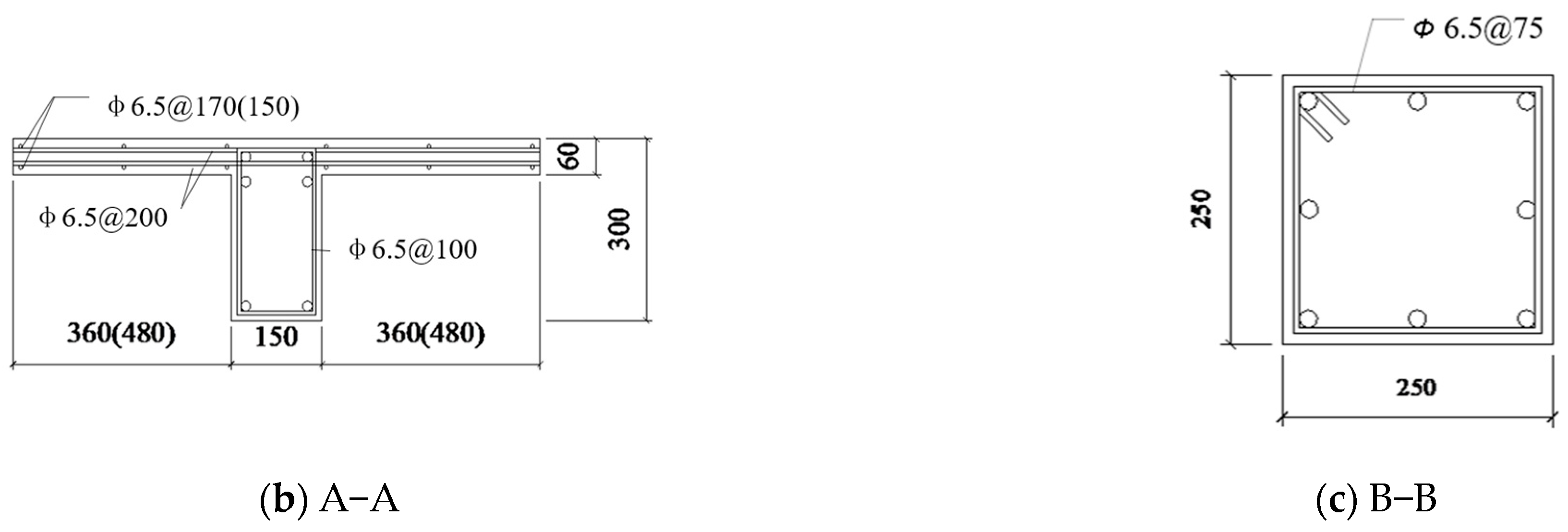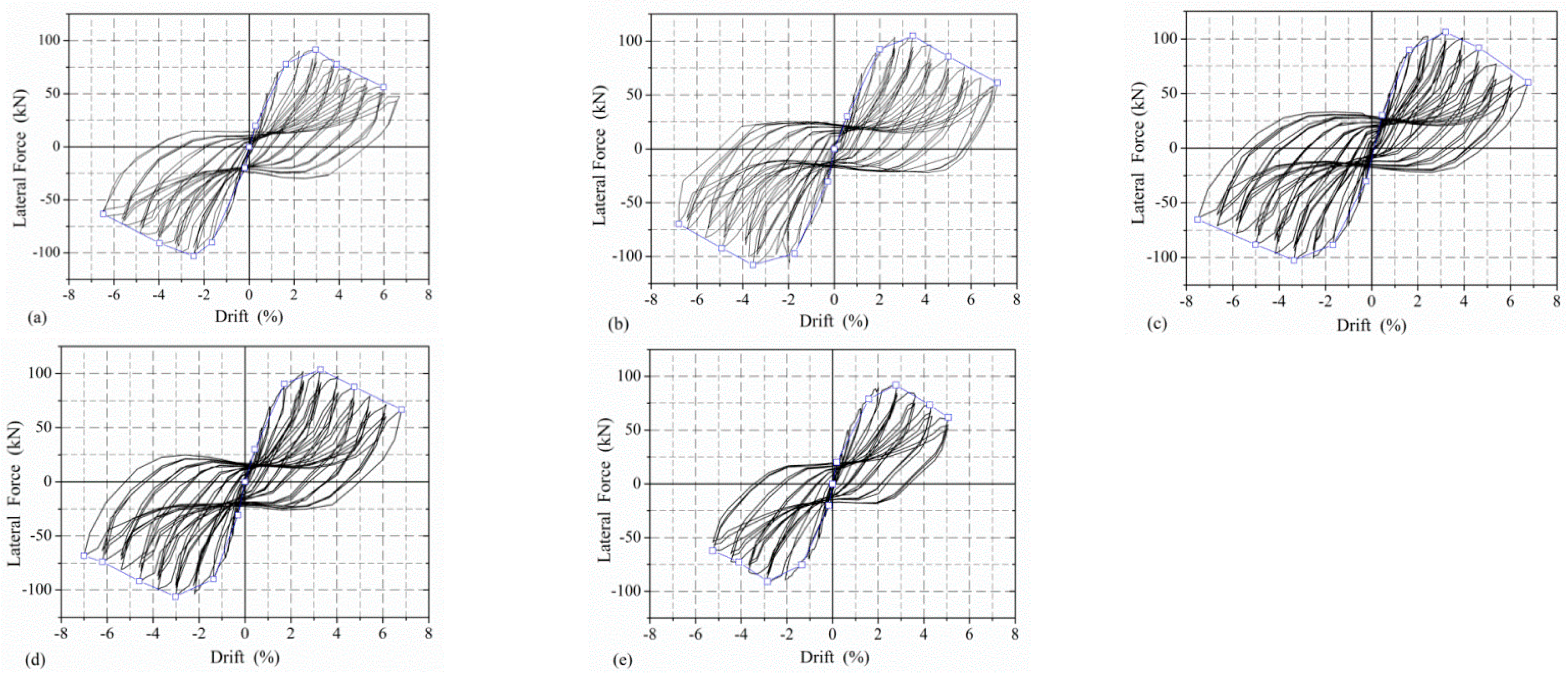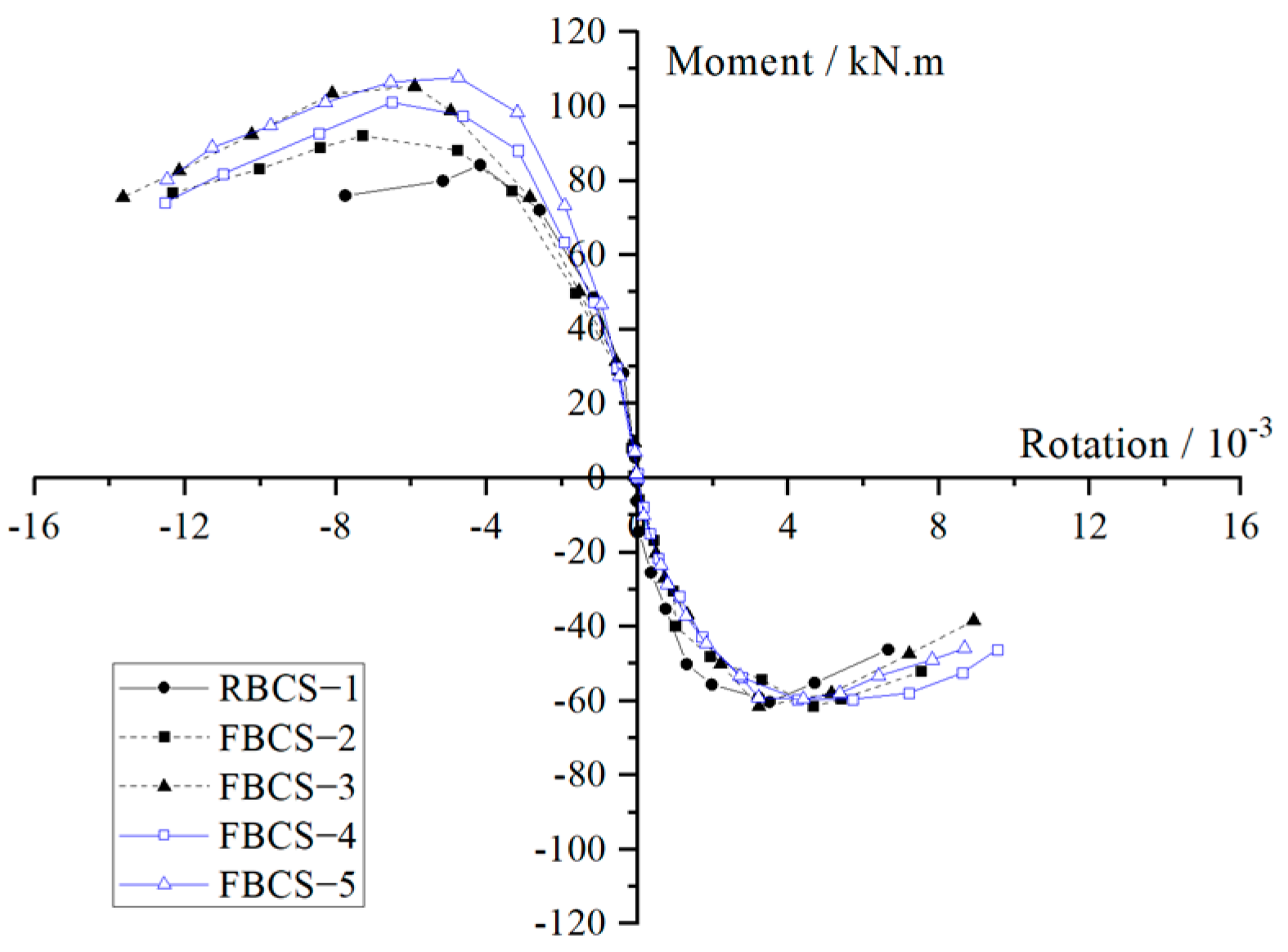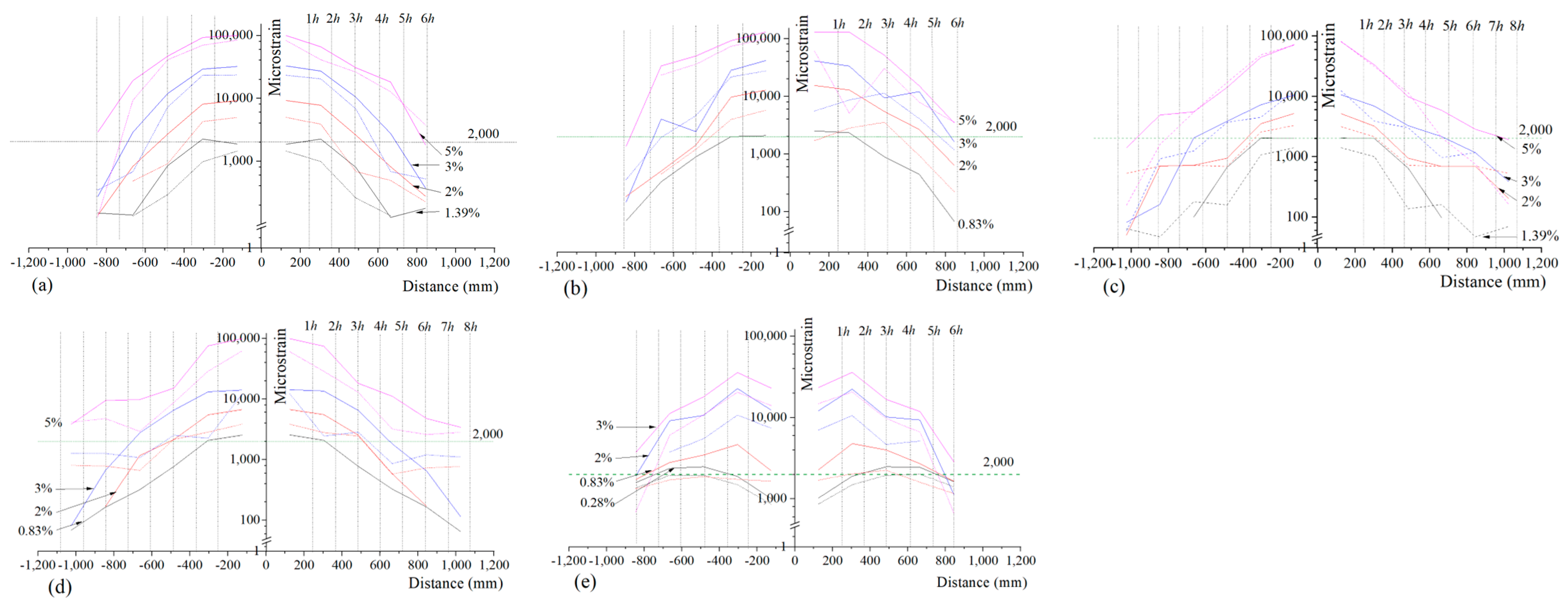The Effect of ECC Materials on Seismic Performance of Beam—Column Subassemblies with Slabs
Abstract
:1. Introduction
2. Materials and Methods
2.1. Design of Experiment
2.2. Material Properties
2.3. Test Setup
3. Results
3.1. Failure Description
3.2. Load versus Deflection Response
3.3. Moment versus Rotation Response
3.4. Stiffness
3.5. Energy Dissipation
3.6. Strain in Slab
4. Numerical Simulation
4.1. Design of the Prototype Models
4.2. Analysis of Simulation Result
5. Conclusions
- (1)
- The maximum bearing capacity of the ECC subassembly was increased by 15% compared to the RC specimens, and the θu was improved by 19%. The Esum (cumulative hysteretic energy) increased by 34%.
- (2)
- The use of the ECC material in an RC beam–column assembly can result in a strong column and weak beam failure mechanism. As shown in the results of the tests and simulations, using the ECC material instead of concrete in key positions of the beam–column–slab subassemblies could reduce the range of slab reinforcement participation to beam flexural strength. At a drift of 2%, the range of the yielding bars in the slab of the RC models was 5~6 times the slab thickness, nearly all the reinforcement in the flange. In comparison, the range of the yielding bars in the slab of the ECC models was 3 times the slab thickness. It is beneficial for beam–column–slab subassemblies to reach the “strong column–weak beam” yielding mechanism.
- (3)
- As the ƞ increased, the cumulative energy dissipation capacity of the beam–column–slab subassemblies increased, and the strength degeneration coefficient decreased. The specimens with a flange width of 8h on both sides of the longitudinal beam had a higher energy dissipation capacity and a reduced the strength degeneration coefficient compared with those with a flange width of 6h.
- (4)
- The range of the yield reinforcement in the flange of specimens FRCS-4 and FRCS-5 was larger than that of specimens FRCS-2 and FRCS-3 at a drift ratio of 3%, because the column flexural strength corresponding to the former was larger than that of the latter. At a drift of 3%, strains on the slab—reinforced bars in the range of 5h reached the yield strain in both the tests and simulations; at a drift of 5%, the strains at the slab bars in the range of approximately 8h reached the yield strain.
- (5)
- The ƞ had some influence on the yielding range in the flange. With the increasing ratios, the strains and range of the yield bars all increased slightly.
Author Contributions
Funding
Data Availability Statement
Acknowledgments
Conflicts of Interest
References
- Civil Structural Groups of Tsinghua University, Xinan Jiaotong University, and Beijing Jiaotong University. Analysis on Seismic Damage of Buildings in the Wenchuan Earthquake. J. Build. Struct. 2008, 4, 1–9. [Google Scholar] [CrossRef]
- Lin, X.C.; Pan, P.; Ye, L.P. Analysis of the Damage Mechanism of a Typical RC Frame in Wenchuan Earthquake. China Civ. Eng. J. 2009, 29, 13–20. [Google Scholar]
- Park, S.; Mosalam, K.M. Experimental Investigation of Nonductile RC Corner Beam—Column Joints with Floor Slabs. J. Struct. Eng. 2013, 39, 1–14. [Google Scholar] [CrossRef]
- GB 50010-2010; Code for Design of Concrete Structures. MOHURD (Ministry of Housing and Urban—Rural Development of China): Beijing, China, 2011.
- ACI 318-2014 and ACI318R-14; Building Code Requirements for Structural Concrete and Commentary. American Concrete Institute: Farmington Hills, MI, USA, 2014.
- NZS3101; Concrete Structures Standard. The trading arm of the Standards Council, Standards New Zealand: Wellington, New Zealand, 2006.
- Pantazopoulou, S.J.; French, C.W. Slab Participation in Practical Earthquake Design of Reinforced Concrete Frames. ACI Struct. J. 2001, 98, 479–489. [Google Scholar]
- Cheung, P.C.; Paulay, T.; Park, R. Mechanism of Slab Contribution in Beam—Column Subassemblages; Design of Beam—Column Joint for Seismic Resistance, ACI SP—123; American Concrete Institute: Farmington Hill, MI, USA, 1991; pp. 259–290. [Google Scholar]
- Dhakal, R.P.; Peng, B.H.H.; Fenwick, R.C.; Carr, A.J.; Bull, D.K. Cyclic Loading Test of Reinforced Concrete Frame with Precast—Prestressed Flooring System. ACI Struct. J. 2014, 111, 777–788. [Google Scholar] [CrossRef]
- Li, V.C.; Kanda, T. Engineered Cementitious Composites for Structural Applications. J. Mater. Civ. Eng. 1998, 10, 66–69. [Google Scholar] [CrossRef] [Green Version]
- Zhang, Q.; Wei, Z.Y.; Gu, X.L.; Yang, Q.H.; Li, S.Y.; Zhao, Y.S. Confinement behavior and stress—strain response of square concrete columns strengthened with carbon textile reinforced concrete (CTRC) composites. Eng. Struct. 2022, 266, 114592. [Google Scholar] [CrossRef]
- Zhang, Q.; Yang, Q.C.; Gu, X.L.; Jiang, Y. Study on axial compression properties of concrete columns wrapped with basalt textile—reinforced fine concrete (BTRC) jackets. Constr. Build. Mater. 2023, 363, 129809. [Google Scholar] [CrossRef]
- Zhang, Q.; Yang, Q.C.; Li, W.J.; Gu, X.L.; Dai, H.H. Study on model of flexure response of Carbon Fiber Textile Reinforced Concrete (CTRC) Sheets with short AR—glass fibers. Case Stud. Constr. Mater. 2023, 18, e01791. [Google Scholar] [CrossRef]
- Fischer, G.; Li, V.C. Deformation Behavior of Fiber—Reinforced Polymer Reinforced Engineered Cementitious Composite (ECC) Flexural Members under Reversed Cyclic Loading Conditions. ACI Struct. J. 2003, 100, 25–35. [Google Scholar]
- Mirzahosseini, H.; Mirhosseini, S.M.; Zeighami, E. Progressive collapse assessment of reinforced concrete (RC) buildings with high—performance fiber—reinforced cementitious composites (HPFRCC). Structures 2023, 49, 139–151. [Google Scholar] [CrossRef]
- Zhang, Y.X.; Yao, X.Y.; Li, T.; Deng, M. Application of engineered cementitious composites in the plastic hinge of reinforced concrete beams for seismic enhancing. Struct. Concr. 2022, 23, 2732–2747. [Google Scholar] [CrossRef]
- Han, S.W.; Lee, S.H. Cyclic behavior of high—performance fiber—reinforced cementitious composite corner joints. J. Build. Eng. 2022, 47, 103892. [Google Scholar] [CrossRef]
- Han, S.W.; Kang, H. Seismic behavior of high—performance fiber reinforced cementitious composites columns with limited reinforcement details. Eng. Struct. 2023, 277, 115419. [Google Scholar] [CrossRef]
- GB50011-2010; Code for Seismic Design of Buildings. MOHURD (Ministry of Housing and Urban—Rural Development of China): Beijing, China, 2010.
- ABAQUS Inc. Abaqus Analysis User’s Manual 6.12; ABAQUS Inc.: Providence, RI, USA, 2012. [Google Scholar]
- Li, Y.; Liang, X.W.; Deng, M.K. A constitutive model for high performance PVA fiber reinforced cement composites under conventional triaxial compression. Eng. Mech. 2012, 29, 106–113. [Google Scholar]













| Specimen Number | Column | Beam | Slab /Flange Width | Composites | η | |
|---|---|---|---|---|---|---|
| Upper | Lower | |||||
| RBCS-1 | 4–18 | 4–16 | 2–16 | ϕ6.5@170 /6h | RC | 1.2 |
| FBCS-2 | 4–18 | R/ECC | 1.2 | |||
| FBCS-3 | 4–18 + 4–16 | R/ECC | 1.4 | |||
| FBCS-4 | 4–16 + 4–14 | ϕ6.5@150 /8h | R/ECC | 1.2 | ||
| FBCS-5 | 8–18 | R/ECC | 1.4 | |||
| d (mm) | fy (Yield Strength, MPa) | fu (Ultimate Strength, MPa) |
|---|---|---|
| 6.5 (HPB300) | 385 | 560 |
| 12 (HRB400) | 472 | 659 |
| 14 (HRB400) | 430 | 615 |
| 16 (HRB400) | 533 | 710 |
| 18 (HRB400) | 460 | 660 |
| 20(HRB400) | 426 | 610 |
| Cycles | P+ (kN) | P− (kN) | ||||||||
|---|---|---|---|---|---|---|---|---|---|---|
| RBCS-1 | FBCS-2 | FBCS-3 | FBCS-4 | FBCS-5 | RBCS-1 | FBCS-2 | FBCS-3 | FBCS-4 | FBCS-5 | |
| 0.75Δy | 80.5 | 78.3 | 82.1 | 88.1 | 85.2 | −80.4 | −85.9 | −92.0 | −87.3 | −93.9 |
| Δy | 92.0 * | 91.5 * | 104.0 | 102.3 | 101.8 | −90.8 * | −103.0 * | −105.9 | −100.6 | −103.7 |
| 2Δy | 84.9 | 82.3 | 105.2 * | 106.3 * | 103.8 * | −84.2 | −99.7 | −107.7 * | −102.6 * | −106.0 * |
| 3Δy | 73.3 | 73.4 | 96.3 | 101.1 | 97.6 | −72.9 | −90.9 | −100.3 | −96.5 | −100.2 |
| 4Δy | 61.6 | 64.2 | 85.6 | 91.9 | 87.7 | 62.0 | −82.6 | −92.4 | −88.2 | −91.7 |
| 5Δy | − | 56.3 | 76.4 | 76.9 | 79.1 | − | −73.7 | −82.4 | −77.9 | −80.8 |
| 6Δy | − | 47.7 | 65.7 | 66.3 | 71.5 | − | −63.4 | −74.3 | −70.8 | −73.6 |
| 7Δy | − | − | 61.4 | 60.4 | 67.0 | − | − | −69.5 | −65.1 | −68.1 |
| Number | Beam | Flange Width | Column | ƞ | ||
|---|---|---|---|---|---|---|
| Longitudinal | Stirrups | Longitudinal | Stirrups | |||
| S-RBCS-1 | 8–22/ 5–22 | 8@100 | 6h a | 8–22 | 8@100/150 (12@100) b | 1.2 |
| S-FBCS-2 | 6h | 8–22 | 8@100/150 (12@100) | 1.2 | ||
| S-FBCS-3 | 6h | 4–25 + 8–22 | 8@100/150 (12@100) | 1.4 | ||
| S-FBCS-4 | 8h | 12–20 | 8@100/150 (12@100) | 1.2 | ||
| S-FBCS-5 | 8h | 16–22 | 8@100/150 (12@100) | 1.4 | ||
| Bars Grade | Yield Strength (MPa) | Yield Strain | Ultimate Strain |
|---|---|---|---|
| HRB400 | 432 | 0.002 | 0.01 |
Disclaimer/Publisher’s Note: The statements, opinions and data contained in all publications are solely those of the individual author(s) and contributor(s) and not of MDPI and/or the editor(s). MDPI and/or the editor(s) disclaim responsibility for any injury to people or property resulting from any ideas, methods, instructions or products referred to in the content. |
© 2023 by the authors. Licensee MDPI, Basel, Switzerland. This article is an open access article distributed under the terms and conditions of the Creative Commons Attribution (CC BY) license (https://creativecommons.org/licenses/by/4.0/).
Share and Cite
Lu, T.; Guan, K.; Pan, J.; Liang, X. The Effect of ECC Materials on Seismic Performance of Beam—Column Subassemblies with Slabs. Buildings 2023, 13, 1942. https://doi.org/10.3390/buildings13081942
Lu T, Guan K, Pan J, Liang X. The Effect of ECC Materials on Seismic Performance of Beam—Column Subassemblies with Slabs. Buildings. 2023; 13(8):1942. https://doi.org/10.3390/buildings13081942
Chicago/Turabian StyleLu, Tingting, Kai Guan, Jiaojiao Pan, and Xingwen Liang. 2023. "The Effect of ECC Materials on Seismic Performance of Beam—Column Subassemblies with Slabs" Buildings 13, no. 8: 1942. https://doi.org/10.3390/buildings13081942






